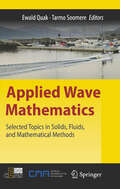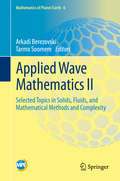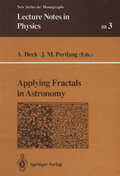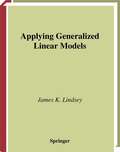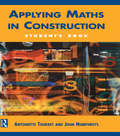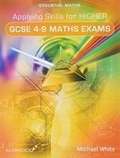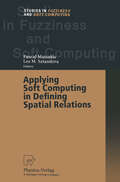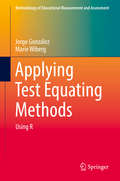- Table View
- List View
Applied Univariate, Bivariate, and Multivariate Statistics Using Python: A Beginner's Guide to Advanced Data Analysis
by Daniel J. DenisApplied Univariate, Bivariate, and Multivariate Statistics Using Python A practical, “how-to” reference for anyone performing essential statistical analyses and data management tasks in PythonApplied Univariate, Bivariate, and Multivariate Statistics Using Python delivers a comprehensive introduction to a wide range of statistical methods performed using Python in a single, one-stop reference. The book contains user-friendly guidance and instructions on using Python to run a variety of statistical procedures without getting bogged down in unnecessary theory. Throughout, the author emphasizes a set of computational tools used in the discovery of empirical patterns, as well as several popular statistical analyses and data management tasks that can be immediately applied.Most of the datasets used in the book are small enough to be easily entered into Python manually, though they can also be downloaded for free from www.datapsyc.com. Only minimal knowledge of statistics is assumed, making the book perfect for those seeking an easily accessible toolkit for statistical analysis with Python. Applied Univariate, Bivariate, and Multivariate Statistics Using Python represents the fastest way to learn how to analyze data with Python.Readers will also benefit from the inclusion of:A review of essential statistical principles, including types of data, measurement, significance tests, significance levels, and type I and type II errorsAn introduction to Python, exploring how to communicate with PythonA treatment of exploratory data analysis, basic statistics and visual displays, including frequencies and descriptives, q-q plots, box-and-whisker plots, and data managementAn introduction to topics such as ANOVA, MANOVA and discriminant analysis, regression, principal components analysis, factor analysis, cluster analysis, among others, exploring the nature of what these techniques can vs. cannot do on a methodological levelPerfect for undergraduate and graduate students in the social, behavioral, and natural sciences, Applied Univariate, Bivariate, and Multivariate Statistics Using Python will also earn a place in the libraries of researchers and data analysts seeking a quick go-to resource for univariate, bivariate, and multivariate analysis in Python.
Applied Wave Mathematics: Selected Topics in Solids, Fluids, and Mathematical Methods
by Ewald Quak Tarmo SoomereThis edited volume consists of twelve contributions related to the EU Marie Curie Transfer of Knowledge Project Cooperation of Estonian and Norwegian Scienti c Centres within Mathematics and its Applications, CENS-CMA (2005-2009), - der contract MTKD-CT-2004-013909, which ?nanced exchange visits to and from CENS, the Centre for Nonlinear Studies at the Institute of Cybernetics of Tallinn University of Technology in Estonia. Seven contributions describe research highlights of CENS members, two the work of members of CMA, the Centre of Mathematics for Applications,Univ- sity of Oslo, Norway, as the partner institution of CENS in the Marie Curie project, and three the ?eld of work of foreign research fellows, who visited CENS as part of theproject. Thestructureofthebookre?ectsthedistributionofthetopicsaddressed: Part I Waves in Solids Part II Mesoscopic Theory Part III Exploiting the Dissipation Inequality Part IV Waves in Fluids Part V Mathematical Methods The papers are written in a tutorial style, intended for non-specialist researchers and students, where the authors communicate their own experiences in tackling a problem that is currently of interest in the scienti?c community. The goal was to produce a book, which highlights the importance of applied mathematics and which can be used for educational purposes, such as material for a course or a seminar. To ensure the scienti?c quality of the contributions, each paper was carefully - viewed by two international experts. Special thanks go to all authors and referees, without whom making this book would not have been possible.
Applied Wave Mathematics II: Selected Topics in Solids, Fluids, and Mathematical Methods and Complexity (Mathematics of Planet Earth #6)
This book gathers contributions on various aspects of the theory and applications of linear and nonlinear waves and associated phenomena, as well as approaches developed in a global partnership of researchers with the national Centre of Excellence in Nonlinear Studies (CENS) at the Department of Cybernetics of Tallinn University of Technology in Estonia.The papers chiefly focus on the role of mathematics in the analysis of wave phenomena. They highlight the complexity of related topics concerning wave generation, propagation, transformation and impact in solids, gases, fluids and human tissues, while also sharing insights into selected mathematical methods for the analytical and numerical treatment of complex phenomena. In addition, the contributions derive advanced mathematical models, share innovative ideas on computing, and present novel applications for a number of research fields where both linear and nonlinear wave problems play an important role.The papers are written in a tutorial style, intended for non-specialist researchers and students. The authors first describe the basics of a problem that is currently of interest in the scientific community, discuss the state of the art in related research, and then share their own experiences in tackling the problem.Each chapter highlights the importance of applied mathematics for central issues in the study of waves and associated complex phenomena in different media. The topics range from basic principles of wave mechanics up to the mathematics of Planet Earth in the broadest sense, including contemporary challenges in the mathematics of society. In turn, the areas of application range from classic ocean wave mathematics to material science, and to human nerves and tissues. All contributions describe the approaches in a straightforward manner, making them ideal material for educational purposes, e.g. for courses, master class lectures, or seminar presentations.
Applying Analytics: A Practical Introduction
by E. S. LevineNewcomers to quantitative analysis need practical guidance on how to analyze data in the real world yet most introductory books focus on lengthy derivations and justifications instead of practical techniques. Covering the technical and professional skills needed by analysts in the academic, private, and public sectors, Applying Analytics: A Practic
Applying and Interpreting Statistics: A Comprehensive Guide (Springer Texts in Statistics)
by Glen McPhersonThis book describes the basis, application, and interpretation of statistics, and presents a wide range of univariate and multivariate statistical methodology. The Second Edition retains the unique feature of being written from the users' perspective; it connects statistical models and methods to investigative questions and background information, and connects statistical results with interpretations in plain English. In keeping with this approach, methods are grouped by usage rather than by commonality of statistical methodology.
Applying Fractals in Astronomy (Lecture Notes in Physics Monographs #3)
by Andre Heck Jean M. Perdang'Fractal geometry addressesitselfto questions that many people have been asking themselves. It con cerns an aspect of Nature that almost everybody had been conscious of, but could not address in a formal fashion. ' 'Fractal geometry seems to be the proper language to describe the complezity of many very compli cated shapes around us. ' (Mandelbrot, 1990a) 'I believe that fractals respond to a profound un easiness in man. ' (Mandelbrot, 1990b) The catchword fractal, ever since it was coined by Mandelbrot (1975) to refer to a class of abstract mathematical objects that were already known at the turn ofthe 19th century, has found an unprecedented resonance both inside and outside the scientific community. Fractal concepts, far more than the concepts of catastrophe theory introduced a few years earlier, are currently being applied not only in the physical sciences, but also in biology and medicine (Goldberger and West 1987). In the mid-eighties, Kadanoff (1986) asked the question: 'Why all the fuss about /ractals'! '. He offered a twofold answer: in the first place, it is 'because of the practical, technological importance of fractal objects'. Indeed he emphasised the relevance of these structures for materials scientists and oil drilling engineers, in search of structures with novel properties, or models for the flow of oil through the soil. His second answer was: 'Because of the intellectual interest of fractals '.
Applying Fuzzy Logic for the Digital Economy and Society (Fuzzy Management Methods)
by Andreas Meier Edy Portmann Luis TeránThis edited book presents the state-of-the-art of applying fuzzy logic to managerial decision-making processes in areas such as fuzzy-based portfolio management, recommender systems, performance assessment and risk analysis, among others. Presenting the latest research, with a strong focus on applications and case studies, it is a valuable resource for researchers, practitioners, project leaders and managers wanting to apply or improve their fuzzy-based skills.
Applying Fuzzy Mathematics to Formal Models in Comparative Politics (Studies in Fuzziness and Soft Computing)
by Terry D. Clark Jennifer M. Larson John N. Mordeson Joshua D. Potter Mark J. WiermanThis book explores the intersection of fuzzy mathematics and the spatial modeling of preferences in political science. Beginning with a critique of conventional modeling approaches predicated on Cantor set theoretical assumptions, the authors outline the potential benefits of a fuzzy approach to the study of ambiguous or uncertain preference profiles. This is a good text for a graduate seminar in formal modeling. It is also suitable as an introductory text in fuzzy mathematics.
Applying Generalized Linear Models (Springer Texts in Statistics)
by James K. LindseyThis book describes how generalised linear modelling procedures can be used in many different fields, without becoming entangled in problems of statistical inference. The author shows the unity of many of the commonly used models and provides readers with a taste of many different areas, such as survival models, time series, and spatial analysis, and of their unity. As such, this book will appeal to applied statisticians and to scientists having a basic grounding in modern statistics. With many exercises at the end of each chapter, it will equally constitute an excellent text for teaching applied statistics students and non- statistics majors. The reader is assumed to have knowledge of basic statistical principles, whether from a Bayesian, frequentist, or direct likelihood point of view, being familiar at least with the analysis of the simpler normal linear models, regression and ANOVA.
Applying Math with Python: Practical Recipes for Solving Computational Math Problems Using Python Programming and Its Libraries
by Sam MorleyPython, one of the world's most popular programming languages, has a number of powerful packages to help you tackle complex mathematical problems in a simple and efficient way. These core capabilities help programmers pave the way for building exciting applications in various domains, such as machine learning and data science, using knowledge in the computational mathematics domain. The book teaches you how to solve problems faced in a wide variety of mathematical fields, including calculus, probability, statistics and data science, graph theory, optimization, and geometry. You'll start by developing core skills and learning about packages covered in Python's scientific stack, including NumPy, SciPy, and Matplotlib. As you advance, you'll get to grips with more advanced topics of calculus, probability, and networks (graph theory). After you gain a solid understanding of these topics, you'll discover Python's applications in data science and statistics, forecasting, geometry, and optimization. The final chapters will take you through a collection of miscellaneous problems, including working with specific data formats and accelerating code. By the end of this book, you'll have an arsenal of practical coding solutions that can be used and modified to solve a wide range of practical problems in computational mathematics and data science.
Applying Math with Python: Practical recipes for solving computational math problems using Python programming and its libraries
by Sam MorleyDiscover easy-to-follow solutions and techniques to help you to implement applied mathematical concepts such as probability, calculus, and equations using Python's numeric and scientific libraries Key Features Compute complex mathematical problems using programming logic with the help of step-by-step recipes Learn how to utilize Python's libraries for computation, mathematical modeling, and statistics Discover simple yet effective techniques for solving mathematical equations and apply them in real-world statistics Book Description Python, one of the world's most popular programming languages, has a number of powerful packages to help you tackle complex mathematical problems in a simple and efficient way. These core capabilities help programmers pave the way for building exciting applications in various domains, such as machine learning and data science, using knowledge in the computational mathematics domain. The book teaches you how to solve problems faced in a wide variety of mathematical fields, including calculus, probability, statistics and data science, graph theory, optimization, and geometry. You'll start by developing core skills and learning about packages covered in Python's scientific stack, including NumPy, SciPy, and Matplotlib. As you advance, you'll get to grips with more advanced topics of calculus, probability, and networks (graph theory). After you gain a solid understanding of these topics, you'll discover Python's applications in data science and statistics, forecasting, geometry, and optimization. The final chapters will take you through a collection of miscellaneous problems, including working with specific data formats and accelerating code. By the end of this book, you'll have an arsenal of practical coding solutions that can be used and modified to solve a wide range of practical problems in computational mathematics and data science. What you will learn Get familiar with basic packages, tools, and libraries in Python for solving mathematical problems Explore various techniques that will help you to solve computational mathematical problems Understand the core concepts of applied mathematics and how you can apply them in computer science Discover how to choose the most suitable package, tool, or technique to solve a certain problem Implement basic mathematical plotting, change plot styles, and add labels to the plots using Matplotlib Get to grips with probability theory with the Bayesian inference and Markov Chain Monte Carlo (MCMC) methods Who this book is for This book is for professional programmers and students looking to solve mathematical problems computationally using Python. Advanced mathematics knowledge is not a requirement, but a basic knowledge of mathematics will help you to get the most out of this book. The book assumes familiarity with Python concepts of data structures.
Applying Maths in Construction
by Antoinette Tourret John HumphreysThis book and its accompanying Teacher's Pack are the result of a project, supported by the Nuffield Foundation, to provide flexible learning materials for the Basic Application of Number core skill for both the NVQs and GNVQ in construction and the construction crafts. The student book uses a unique approach to explain how mathematical principles apply to construction tasks. Each chapter forms an individual construction project and uses the full range of number skills from the fundamentals of addition and subtraction to statistics, trigonometry and technical drawing. Successfully completed projects provide the student with the required portfolio of evidence for their course. Notes throughout the text refer the student to the relevant module in the Teacher's Pack, which contains assessments, tests and detailed explanations of the number skills needed to complete the projects.
Applying Maths in Construction
by Antoinette Tourret John HumphreysThis book and its accompanying Teacher's Pack are the result of a project, supported by the Nuffield Foundation, to provide flexible learning materials for the Basic Application of Number core skill for both the NVQs and GNVQ in construction and the construction crafts. The student book uses a unique approach to explain how mathematical principles apply to construction tasks. Each chapter forms an individual construction project and uses the full range of number skills from the fundamentals of addition and subtraction to statistics, trigonometry and technical drawing. Successfully completed projects provide the student with the required portfolio of evidence for their course. Notes throughout the text refer the student to the relevant module in the Teacher's Pack, which contains assessments, tests and detailed explanations of the number skills needed to complete the projects.
Applying Particle Swarm Optimization: New Solutions and Cases for Optimized Portfolios (International Series in Operations Research & Management Science #306)
by Burcu Adıgüzel MercangözThis book explains the theoretical structure of particle swarm optimization (PSO) and focuses on the application of PSO to portfolio optimization problems. The general goal of portfolio optimization is to find a solution that provides the highest expected return at each level of portfolio risk. According to H. Markowitz’s portfolio selection theory, as new assets are added to an investment portfolio, the total risk of the portfolio’s decreases depending on the correlations of asset returns, while the expected return on the portfolio represents the weighted average of the expected returns for each asset.The book explains PSO in detail and demonstrates how to implement Markowitz’s portfolio optimization approach using PSO. In addition, it expands on the Markowitz model and seeks to improve the solution-finding process with the aid of various algorithms. In short, the book provides researchers, teachers, engineers, managers and practitioners with many tools they need to apply the PSO technique to portfolio optimization.
Applying Power Series to Differential Equations: An Exploration through Questions and Projects (Problem Books in Mathematics)
by James Sochacki Anthony TongenThis book is aimed to undergraduate STEM majors and to researchers using ordinary differential equations. It covers a wide range of STEM-oriented differential equation problems that can be solved using computational power series methods. Many examples are illustrated with figures and each chapter ends with discovery/research questions most of which are accessible to undergraduate students, and almost all of which may be extended to graduate level research. Methodologies implemented may also be useful for researchers to solve their differential equations analytically or numerically. The textbook can be used as supplementary for undergraduate coursework, graduate research, and for independent study.
Applying Public Opinion in Governance: The Uses and Future of Public Opinion in Managing Government
by Scott Edward BennettThis book explores how public opinion is used to design, monitor and evaluate government programmes in Australia, Canada, New Zealand, and the United Kingdom. Using information collected from the media and from international practitioners in the public opinion field, as well as interviews in each of the 4 countries, the author describes how views of public opinion and governance differ significantly between elites and the general public. Bennett argues that elites generally risk more by allowing the creation of new data, fearing that its analysis may become public and create communications and political problems of various kinds. The book finds evidence that recent conservative governments in several countries are changing their perspective on the use of public opinion, and that conventional public opinion studies are facing challenges from the availability of other kinds of information and new technologies. This book is a hugely valuable contribution to a hitherto little explored field and will appeal to academics and practitioners alike.
Applying Public Opinion in Governance: The Uses and Future of Public Opinion in Managing Government
by Scott Edward BennettThis book explores how public opinion is used to design, monitor and evaluate government programmes in Australia, Canada, New Zealand, and the United Kingdom. Using information collected from the media and from international practitioners in the public opinion field, as well as interviews in each of the 4 countries, the author describes how views of public opinion and governance differ significantly between elites and the general public. Bennett argues that elites generally risk more by allowing the creation of new data, fearing that its analysis may become public and create communications and political problems of various kinds. The book finds evidence that recent conservative governments in several countries are changing their perspective on the use of public opinion, and that conventional public opinion studies are facing challenges from the availability of other kinds of information and new technologies. This book is a hugely valuable contribution to a hitherto little explored field and will appeal to academics and practitioners alike.
Applying Quantitative Bias Analysis to Epidemiologic Data (Statistics for Biology and Health)
by Matthew P. Fox Timothy L. Lash Aliza K. FinkBias analysis quantifies the influence of systematic error on an epidemiology study’s estimate of association. The fundamental methods of bias analysis in epi- miology have been well described for decades, yet are seldom applied in published presentations of epidemiologic research. More recent advances in bias analysis, such as probabilistic bias analysis, appear even more rarely. We suspect that there are both supply-side and demand-side explanations for the scarcity of bias analysis. On the demand side, journal reviewers and editors seldom request that authors address systematic error aside from listing them as limitations of their particular study. This listing is often accompanied by explanations for why the limitations should not pose much concern. On the supply side, methods for bias analysis receive little attention in most epidemiology curriculums, are often scattered throughout textbooks or absent from them altogether, and cannot be implemented easily using standard statistical computing software. Our objective in this text is to reduce these supply-side barriers, with the hope that demand for quantitative bias analysis will follow.
Applying Quantitative Bias Analysis to Epidemiologic Data (Statistics for Biology and Health)
by Matthew P. Fox Richard F. MacLehose Timothy L. LashThis textbook and guide focuses on methodologies for bias analysis in epidemiology and public health, not only providing updates to the first edition but also further developing methods and adding new advanced methods. As computational power available to analysts has improved and epidemiologic problems have become more advanced, missing data, Bayes, and empirical methods have become more commonly used. This new edition features updated examples throughout and adds coverage addressing: Measurement error pertaining to continuous and polytomous variables Methods surrounding person-time (rate) data Bias analysis using missing data, empirical (likelihood), and Bayes methods A unique feature of this revision is its section on best practices for implementing, presenting, and interpreting bias analyses. Pedagogically, the text guides students and professionals through the planning stages of bias analysis, including the design of validation studies and the collection of validity data from other sources. Three chapters present methods for corrections to address selection bias, uncontrolled confounding, and measurement errors, and subsequent sections extend these methods to probabilistic bias analysis, missing data methods, likelihood-based approaches, Bayesian methods, and best practices.
Applying Respondent Driven Sampling to Migrant Populations: Lessons from the Field
by G. Tyldum L. JohnstonThis book gives a thorough introduction to the theoretical and practical aspects of planning, conducting and analysing data from Respondent Driven Sampling surveys, drawing on the experiences of experts in the field as well as pioneers that have applied Respondent Driven Sampling methodology to migrant populations.
Applying Soft Computing in Defining Spatial Relations (Studies in Fuzziness and Soft Computing #106)
by Pascal Matsakis Les M. SztanderaGeometric properties and relations play central roles in the description and processing of spatial data. The properties and relations studied by mathematicians usually have precise definitions, but verbal descriptions often involve imprecisely defined concepts such as elongatedness or proximity. The methods used in soft computing provide a framework for formulating and manipulating such concepts. This volume contains eight papers on the soft definition and manipulation of spatial relations and gives a comprehensive summary on the subject.
Applying Test Equating Methods: Using R (Methodology of Educational Measurement and Assessment)
by Jorge González Marie WibergThis book describes how to use test equating methods in practice. The non-commercial software R is used throughout the book to illustrate how to perform different equating methods when scores data are collected under different data collection designs, such as equivalent groups design, single group design, counterbalanced design and non equivalent groups with anchor test design. The R packages equate, kequate and SNSequate, among others, are used to practically illustrate the different methods, while simulated and real data sets illustrate how the methods are conducted with the program R. The book covers traditional equating methods including, mean and linear equating, frequency estimation equating and chain equating, as well as modern equating methods such as kernel equating, local equating and combinations of these. It also offers chapters on observed and true score item response theory equating and discusses recent developments within the equating field. More specifically it covers the issue of including covariates within the equating process, the use of different kernels and ways of selecting bandwidths in kernel equating, and the Bayesian nonparametric estimation of equating functions. It also illustrates how to evaluate equating in practice using simulation and different equating specific measures such as the standard error of equating, percent relative error, different that matters and others.
Applying the Rasch Model: Fundamental Measurement in the Human Sciences
by Trevor Bond Zi Yan Moritz HeeneRecognised as the most influential publication in the field, ARM facilitates deep understanding of the Rasch model and its practical applications. The authors review the crucial properties of the model and demonstrate its use with examples across the human sciences. Readers will be able to understand and critically evaluate Rasch measurement research, perform their own Rasch analyses and interpret their results. The glossary and illustrations support that understanding, and the accessible approach means that it is ideal for readers without a mathematical background. Highlights of the new edition include: More learning tools to strengthen readers’ understanding including chapter introductions, boldfaced key terms, chapter summaries, activities and suggested readings. Greater emphasis on the use of R packages; readers can download the R code from the Routledge website. Explores the distinction between numerical values, quantity and units, to understand the measurement and the role of the Rasch logit scale (Chapter 4). A new four-option data set from the IASQ (Instrumental Attitude towards Self-assessment Questionnaire) for the Rating Scale Model (RSM) analysis exemplar (Chapter 6). Clarifies the relationship between Rasch measurement, path analysis and SEM, with a host of new examples of Rasch measurement applied across health sciences, education and psychology (Chapter 10). Intended as a text for graduate courses in measurement, item response theory, (advanced) research methods or quantitative analysis taught in psychology, education, human development, business, and other social and health sciences. Professionals in these areas will also appreciate the book’s accessible introduction.

